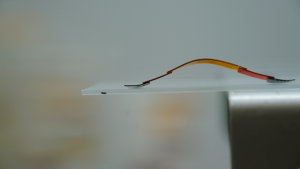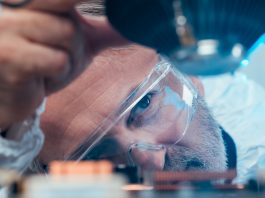Engineers at the University of Waterloo have developed a soft robot, inspired by geckos and inchworms, that can move on any surface.
The soft robot developed by the team uses ultraviolet (UV) light and magnetic force to move on any surface, even up walls and across ceilings, imitating the gripping ability of geckos and the efficient locomotion of inchworms. In the future, the robot – approximately four centimetres long, three millimetres wide and one millimetre thick – could help doctors perform surgery.
The paper, ‘Gecko-and-inchworm-inspired untethered soft robot for climbing on walls and ceilings,’ appears in the journal Cell Reports Physical Science.
What is a soft robot?
Traditionally, robots have been constructed with hard materials such as metal and plastic, resembling machines rather than biological organisms. Alternatively, soft robotics aims to create flexible robots that resemble the locomotive mechanisms of soft bodies that exist in nature, for example, snakes, eels, and inchworms.
Soft robots are comprised of materials that can easily be shaped, such as fluids, gels, and elastomers. Due to their ability to change shape, soft robots can be used to aid in surgeries and to access previously inaccessible places.
The new robot has many potential applications due to its unique characteristics

The soft robot developed by the researchers is the first of its kind that does not require a connection to an external power supply. This allows for remote operation and flexibility for potential applications, for example, assisting in surgery and searching inaccessible places.
“This work is the first time a holistic soft robot has climbed on inverted surfaces, advancing state-of-the-art soft robotics innovation,” said Dr Boxin Zhao, a professor of chemical engineering. “We are optimistic about its potential, with much more development, in several different fields.”
The technology is inspired by nature
Named the GeiwBot because of the creatures that inspired it, the researchers constructed the robot from a smart material, allowing it to be altered at the molecular level to imitate how geckos stick and unstick powerful grippers on their feet. This lets the robot climb on a vertical wall and across the ceiling without being tethered to a power source.
The team developed the robot using liquid crystal elastomers and synthetic adhesive pads. The arching and stretching motion of an inchworm are replicated with a light-responsive polymer strip and the gecko-inspired magnet pads at either end do the gripping.
“Even though there are still limitations to overcome, this development represents a significant milestone for utilising biomimicry and smart materials for soft robots,” said Zhao. “Nature is a great source of inspiration and nanotechnology is an exciting way to apply its lessons.”
Next steps for the researchers
An untethered soft robot can be used in surgical applications through remote operation inside the human body and for searching in dangerous and inaccessible places during rescue missions.
Now, the researchers aim to develop a soft robot that is solely driven by light, does not need a magnetic field, and uses near-infrared radiation instead of UV light to improve biocompatibility.









